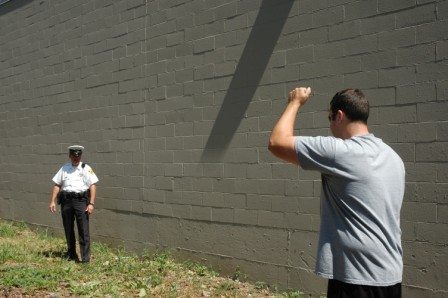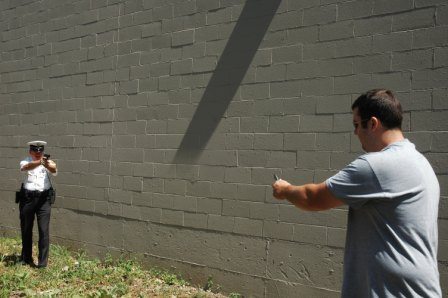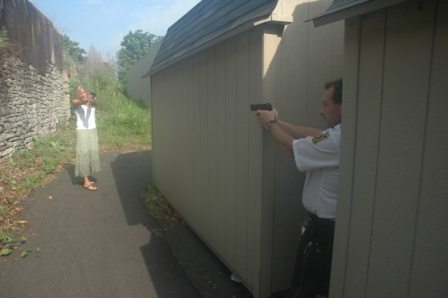Sorry, But To Protect And Serve Does Not Include Taking A Bullet For You
Police officers are forced to make many split second decisions during the course of their careers, and one of those decisions is when to use force, and which level of force should be employed, if needed.
Should a Taser be used when a combative suspect is holding a knife? Should the officer go for her firearm if the suspect is swinging a baseball bat at her head? Is an officer ever justified to shoot an unarmed suspect? Are there situations when officers must retreat? All these decisions are made within one-half to three-quarters of a second. That’s about how long it takes the average human to react to a given situation.
Let’s first examine the scenario pictured above. Here, an officer stands facing a knife-wielding suspect who clearly presents a danger. The bad guy is holding an edged weapon (a knife) in the classic “ice pick” position. Years ago officers were taught that a suspect could be shot, and justifiably so, if he were wielding a knife in a threatening manner while positioned within a distance of twenty-one feet (the 21 foot rule) from the officer. The reasoning was that the suspect was without a doubt an immediate, deadly threat. Officers were taught that they’d not likely survive this scenario without using deadly force. The fact is, it’s doubtful that an officer could draw his weapon and squeeze off a round, without aiming, if a suspect began his charge from a distance of twenty-one feet or less.
Suppose the officer properly assessed the incoming threat and managed to draw his weapon and fire. How long would it take to think about and perform those two basic tasks? Inquiring minds wanted to know so they conducted a series of experiments.
The fastest officer tested was able to draw his weapon from a security holster in a little under 1.5 seconds. The slowest was a about 2.25 seconds. Sounds pretty fast, huh? Maybe not.
The average suspect can cover the distance (21 feet as seen above) from a standing still position to the officer in as little as 1.5 seconds, nearly a full second quicker than the slowest officer is able to defend himself.
Today officers must rethink the twenty-one foot rule a bit. Sure, the thug (a universal term for “bad guy”) is potentially a deadly threat, but not an actual deadly threat until he makes some sort of hostile movement toward the officer. Of course the officer should have his firearm in a ready position as soon as he perceives the threat. By the way, this is definitely a situation where the officer should always choose his firearm over a non-lethal weapon, such as a Taser or pepperspray. Remember the the old saying, “Never bring a knife to a gunfight?” Now there’s a new addition to that rule—“Never bring a Taser to a knife fight.”
The key to knowing when it’s time to shoot is simple. If the officer feels that his life, or the life of an innocent person, is at risk, then the shoot is justified. However, the officer must be prepared to articulate his reasons for pulling the trigger. Was the suspect making stabbing motions while advancing? Was he charging the officer? Was his/her or the life of someone else in jeopardy? Was there a threat of serious bodily harm?
There are reasons, too, that may not justify the shoot, such as the suspect being so intoxicated that he couldn’t possibly have followed through with the threat. In short, the threat must be real, or at least perceived as being real in the eyes of the officer.
And, the officer must be able to recognize when a threat is over. If the suspect drops his weapon the justification for deadly force ends immediately. The same is true when a suspect uses an automobile as a weapon. When a driver uses his car to charge an officer, the officer may shoot to stop the threat. However, when the car speeds past the officer, heading into the sunset, the threat is over. In most circumstances the officer may not shoot at the fleeing car. Where would those rounds go? Besides, bullets won’t stop a moving car. Suppose the driver is shot? What happens to a driverless car that’s careening down a busy street at 50mph?
When any suspect points a firearm of any type at an officer, deadly force is immediately justified.
In situations like the one pictured above, it’s not uncommon for officers to hesitate briefly before using deadly force to stop the threat. Why? Interestingly, officers often perceive women and children as being less of a threat than a male suspect. That’s why Meggitt and other simulated firearms training uses both women and children in the shoot/don’t shoot scenarios. The woman in the picture above is very much a deadly threat; therefore, the officer is justified in using deadly force.
Let’s see how well you do with a short true or false quiz. The answers are posted at the end of the quiz.
True or False
1. There are constitutional limits on the types of weapons and tactics officers can use on the street.
2. An officer’s intent and state of mind at the time she used force can be an important factor in determining if that use of force was legal.
3. An officer must always retreat before using deadly force.
4. Officers MUST see a suspect’s weapon before using deadly force.
5. Officers must always use the least amount of force possible to gain control of a suspect.
6. Officers may shoot a fleeing felon.
7. Officers may not use force when conducting a pat down (Terry stop) search for weapons.
8. Information discovered after using force can be a factor in determining the legality of the force used.
9. Courts and juries are allowed to evaluate an officer’s use of force by considering what the officer could have done differently.
10. An officer’s prior use of force incidents can be considered in court when evaluating whether the use of force in a current situation was legally justified.
*By the way, police officers are not taught to kill anyone. Not ever. Instead, they’re taught to stop a threat to life. And, it’s not always a firearm or edged weapon that threatens human life. Victims, including armed police officers, have been beaten to death by suspects using no more than their bare hands.
Quiz Source – Circuit Court Judge Emory Pitt, Jr. and Americans for Effective Law Enforcement
Answers 1F, 2F, 3F, 4F, 5F, 6T, 7F, 8F, 9F, 10F







